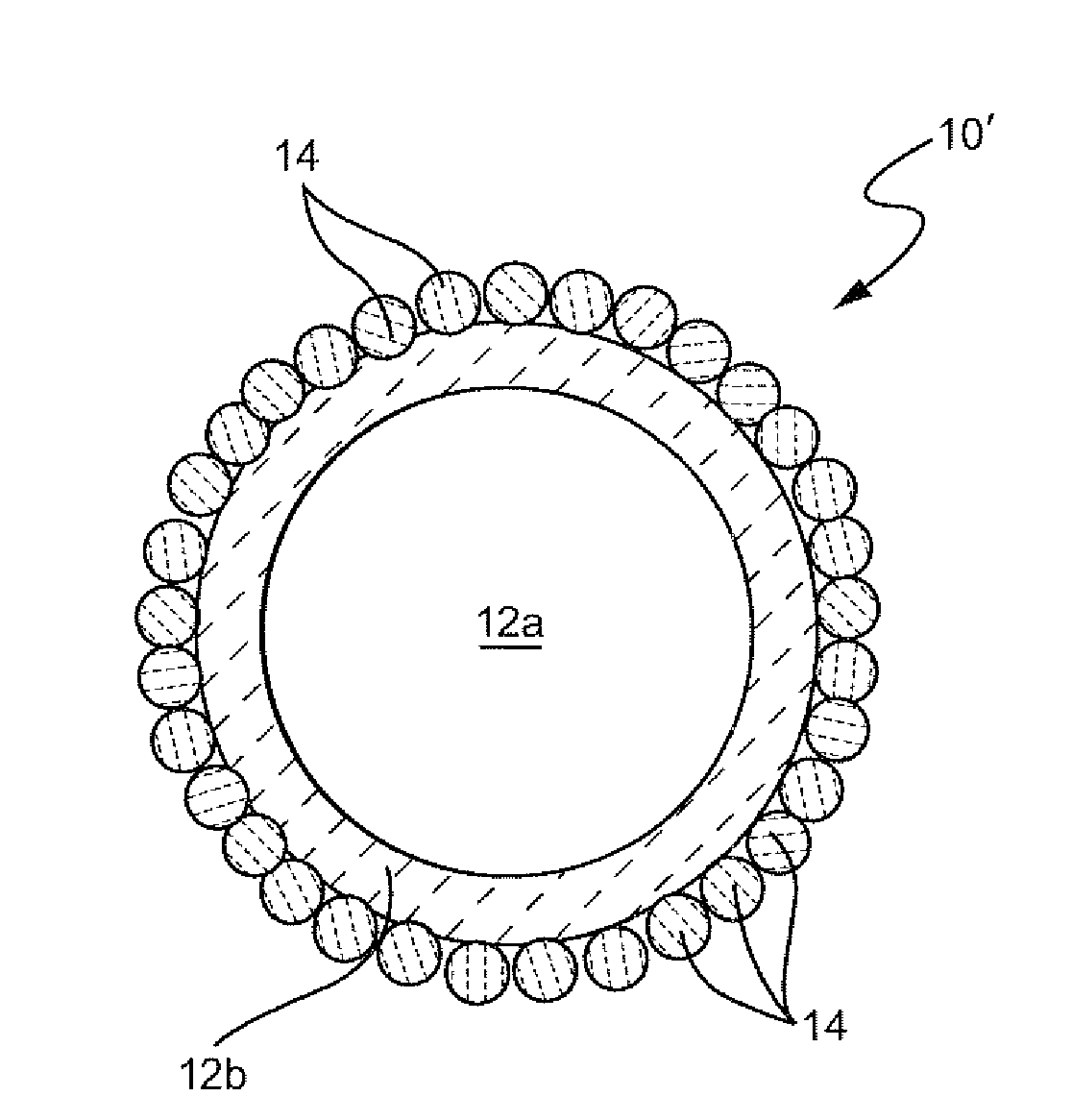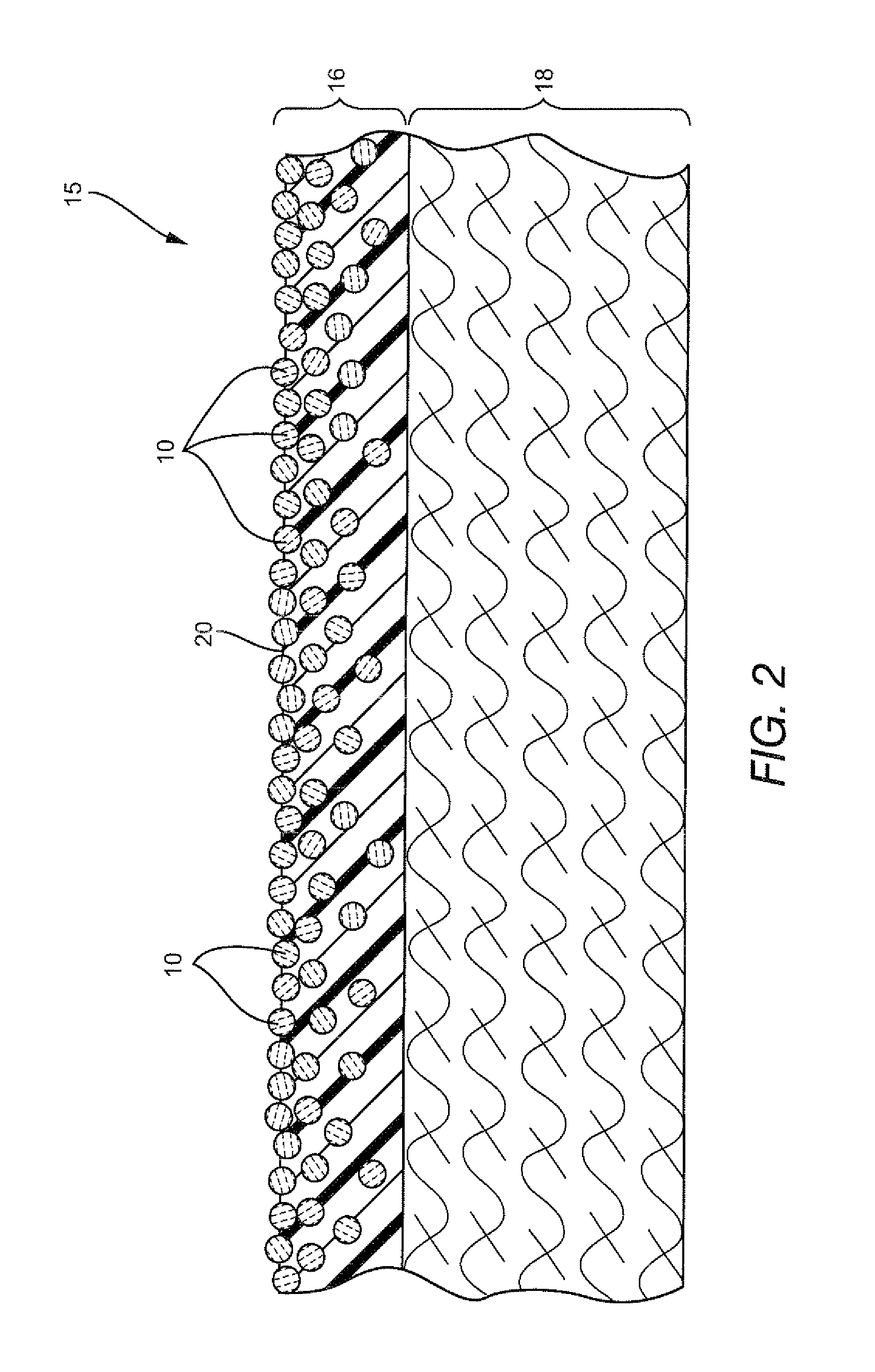Additive particles having superhydrophobic characteristics and coatings and methods of making and using the same
a technology of additive particles and superhydrophobic properties, applied in the field of additive particles, can solve the problems of insufficient surface finish, limited substrates, and inability to produce nanofibers by electrospinning, and achieve the effects of improving surface finish, reducing surface finish, and improving surface finish
- Summary
- Abstract
- Description
- Claims
- Application Information
AI Technical Summary
Benefits of technology
Problems solved by technology
Method used
Image
Examples
example 1
Particle Surface Treatment
[0062]A. Amino Functionalized Silica (SiO2:NH2)
[0063]3-aminopropyl triethoxysilane, NH2(CH2)3Si(OC2H5)3, (0.2 g, 0.90 mmol) was added to 95% ethanol (50 ml). The pH of the solution was lowered to about 5 with the addition of acetic acid, and was allowed to stand for 5 minutes. SiO2 particles with an average diameter of about 60 μm (1 g) was added, and the suspension was treated in an ultrasound bath for 20 minutes. The ethanolic suspension was heated to dryness on a hot plate, and the resulting powder was then heated in an oven at 110° C. overnight to remove excess silane and obtain amino functionalized silica particles. This technique was repeated using silica particles of the following average diameters: 60 μm, 40 μm, 14 μm, 12 μm, 0.5 μm, and 0.25 μm.
[0064]B. Epoxide Functionalized Silica (SiO2:Epoxy)
[0065]The technique described above in Example 1A with reference to the amino functionalized silica was repeated except that 3-glycidyloxypropyl(trimethoxy)...
example 2
Covalent Bonding of Nanoparticles onto Carrier Microparticles
[0068]Amino functionalized silica nanoparticles of selected sizes 15-500 nm) prepared according to Example 1A above were reacted with epoxy functionalized silica carrier microparticles of selected sizes (12-60 μm). the amino functionalized silica nanoparticles (0.1 g) were suspended in ethanol (50 ml), following which the epoxy functionalized silica carrier microparticles (1 g) were added). The solution was stirred for 1 hour under sonication, followed by stirring overnight. The solid was filtered out and dried at 100° C. in air. Scanning electron microscopy (FIG. 4) confirmed that the surface of the carrier microparticles were covered by nanoparticles.
example 3a
Electrostatic Deposition of Nanoparticles onto Carrier Microparticles and Silicon Surface Treatment
[0069]Anionic silica nanoparticles (Snowtex 40, 20-40 nm average particle diameter, Snowtex 20L, 40-50 nm average particle diameter and Snowtex ZI 70-100 nm average particle diameter—Nissan Industries) were deposited electrostatically onto cationic micron sized silica carrier particles. The electrostatic deposition process was performed by stirring the ammonium functionalized silica obtained in Example 1D above. The ammonium functionalized silica (1 g) was suspended in 80 ml H2O, followed by the addition of 2 ml of the anionic silica nanoparticles. Upon stirring for 2 hours, the material was filtered, washed with water and dried at 100° C. overnight. Scanning electron microscopy showed that the particles were dual morphology, that is the surface of the microparticles was covered by nanoparticles.
[0070]Heptadecafluoro-1,1,2,2-tetrahydrodecyl)trimethoxy silane (CF3(CF2)7(CH2)2Si(OCH3)3) ...
PUM
| Property | Measurement | Unit |
|---|---|---|
| diameter | aaaaa | aaaaa |
| diameters | aaaaa | aaaaa |
| diameters | aaaaa | aaaaa |
Abstract
Description
Claims
Application Information
 Login to View More
Login to View More - R&D
- Intellectual Property
- Life Sciences
- Materials
- Tech Scout
- Unparalleled Data Quality
- Higher Quality Content
- 60% Fewer Hallucinations
Browse by: Latest US Patents, China's latest patents, Technical Efficacy Thesaurus, Application Domain, Technology Topic, Popular Technical Reports.
© 2025 PatSnap. All rights reserved.Legal|Privacy policy|Modern Slavery Act Transparency Statement|Sitemap|About US| Contact US: help@patsnap.com



